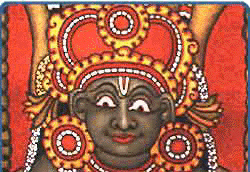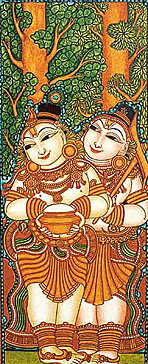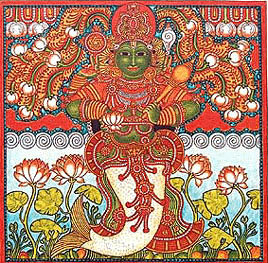
|
|
|
|
BY: JAHNAVA DEVI
 May 05, 2012 — CANADA (SUN) — A three-part series on Kerala's magnificent legacy of temple murals. Kerala Murala are very stylised art forms. There are two predominant styles found and in both, the human and divine forms are rendered. With elongated eyes, painted lips and finely exaggerated eyebrows the rendering is typically stylised reflecting a particular school. The body features, hand gestures rendered with running curves and over ornamentation are other features. The figures of animals and birds are more naturalistic.
One style, Panchavarna, is recognizable by the bold primary colors of yellow, red, green, blue and black, with the images having sharply defined colour fields edged in black. The second school known for softer earth tone colours, with figures softly outlined.
While the traditional paintings were made on walls in the olden days, today any surface like paper, canvas, cardboard, plywood and terracotta can find space for a mural. These departures from tradition were required in order to sustain the interest in the art form. Murals are also done on pots, which are either made of clay or fibre. Even walls of houses, hotels, business centers and workplaces can be filled with mural painting.
The wall preparation for the mural painting is a laborious and time-consuming process. The line drawing is made initially on the prepared wall and subsequently the colours are filled. The process of getting a mural done is rather extensive involving minute technical detailing. Adherence to fine aspects is necessary to create murals, which are brilliant and exquisite. Compliance to the well-developed traditional practices and methods enhances the life of the mural.
Preparation of Wall
Preparation of the surface on which the painting is to be done takes immense importance in executing a mural painting. Lime and dry sand are mixed, crushed and kept aside for four days. A solution of molasses prepared by mixing appropriate quantity of sugar with water is poured into the lime mortar solution and mixed well. This mix is spread evenly on the wall surface leaving the surface rough. In order to smoothen the rough surface, some more mortar mixture is finely prepared by grinding it well and this paste is applied on the rough surface to the thickness of two tamarind leaves and left to dry. Lime mixed with tender coconut water is filtered with a fine piece of cotton cloth and applied on the wall as the next coat. This process is normally repeated 21 times in the conventional method with the help of brush made out of beaten tree bark.
There is another method for preparing the wall for murals. Lime, with powdered pisum sativum is mixed with jaggery in water and then boiled with soil and raw banana juice to make a paste. The paste is kept in a container made of wood and stirred daily, for nearly 60 days. Then it is mixed with kadukka water or juice extracted out of a plant called chunnambu valli. The paste thus formed is coated on the wall and polished for final finish.
Colours
Murals like the Nara-Narayana panel here featur five colours (Panchavarna), namely yellow ochre, Indian red, Indigo, Sabgreen and lampblack are generally used. Blue, the one among the primary colours is given less importance in mural paintings. Yellow pigments are obtained from soft laterite. The soft laterite can be obtained from the ground covered with red soil. This laterite is ground well in manual stone mortar and put in water and the impurities removed by decantation. Then it is dried and preserved for further use. Decantation can be done multiple times in order to obtain a high quality clear pigment which is subsequently dried and kept for later use. For this purpose the yellow and red stones are separately processed.
The quality of the colour essentially depends on the selection of the stone and proper cleaning. Blue pigment is made from the juice extracted out of indigo leaves. The liquid is purified by filtration and then dried. Leaves of a plant called as Neelamari or Neelachetti is squeezed and the extract is used after drying up to be mixed with Eruvikkara for obtaining the green pigment. Alternatively, green colour is obtained by mixing and grinding blue colour with the sap (gum) of the 'eravi' plant. The black smoke deposited on the surface of a mud pot kept over a cloth soaked and dried in indigo extract and lit after moistening it with gingely oil is scratched and used as black. Cow dung mixed with its urine and filtered is used as brown colour. Some of the pigments are mixed with 'neem gum'. Some water is added and stirred well until a thick fluid is formed and subsequently decanted. All colours are prepared in the same way. In preparing black colour, the sediment is not removed as in the other cases. The colours thus prepared are used by adding appropriate quantity of water and neem glue before the painting is done.
Painting & Colouring
In the traditional method, a pencil called as Kittalekhini is prepared by grinding a black stone and mixing it with cow dung. Nowadays artists use different methods including the commercially available pencils, mostly in yellow colour.
An outline is first sketched using charcoal or dung crayons, which is then painted in with appropriate colours. Light yellow colour is also mostly used for sketching, as pencil may spoil the purity of colours. Colouring of the characters goes by their virtue or characteristics - as defined in the Bhagavad Gita. The spiritual, divine and dharmic characters (satva guna) are depicted in shades of green. Those influenced towards power and materialistic wealth (rajo guna) are painted in shades of red to golden yellow. The evil, wicked and mean characters (tamo guna) are generally painted in white or black. Green and blue colours are to be painted only after applying two or three coatings of copper sulphate solution on the place where they are to be applied. In order to deepen colour, additional coatings are applied. Yellow, red, green, blue, black colours are to be used in that order and must be clearly demarcated by black lines. Care should be taken to ensure that other colours do not spill over the white area, as the mural does not allow using any special white colour.
Brushes
The grass locally called 'Eyyam Pullu' in Kerala in the shape of an arrow is used for making brushes. These grow abundantly in the riverbanks. Fully matured grass is boiled with paddy. Then the chaff or the weaker part is removed and fastened together. This is the brush. This brush is tied to a small bamboo stick. The thickness of the brush is adjusted according to needs.
In tomorrow's third and final segment, we'll explore several more examples of the style of Kerala murals typically done in earth-toned colours.
Source: Rejuvenating Ancient Arts of South India (RASI)
| |


